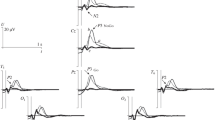Abstract
This paper describes a method for estimating a set of spatial components (brain maps) and temporal components (waveforms) of brain potentials. These components play the role of bases of a coordinate system, in the sense that the brain potentials of any subject can be represented as superpositions of these components. The representation is unique given the spatial and temporal components, and this decomposition is particularly appealing for comparing the brain potentials of different subjects (say alcoholics and controls). It can also be used for single trial modeling, clinical classification of patients, and data filtering. The method is based on the topographic component model (TCM, Möcks 1988) which models brain potentials in a trilinear form. We extend the TCM in two aspects. First, the diagonal amplitude matrix is replaced by a general loading matrix based on some neurophysiological considerations. Secondly, the number of spatial components and the number of temporal components can be different. The spatial components and temporal components are obtained respectively by performing singular value decomposition (SVD). This method is illustrated with visual P3 data.
Similar content being viewed by others
References
Achim, A. and Bouchard, S. Toward a dynamic topographic components model. Electroenceph. Clin. Neurophys., 1997, 103: 381-385.
Bell, A. and Sejnowski, T. An information-maximization approach to blind separation and blind deconvolution. Neural Comp., 1995, 7: 1129-1159.
Donchin, E. and Heffley, E. Multivariate analysis of event-related potential data: A tutorial review. In: D. Otto (Ed.), Multidisciplinary perspectives in event-related brain potential research, U.S. Gov. Printing Office, Washington DC, 1978: 555-572.
Field, S. and Graupe, D. Topographic components analysis of evoked potentials: estimation of model parameters and evaluation of parameter uniqueness. J. Biomed. Eng., 1990, 12: 287-300.
Field, S. and Graupe, D. Topographic component (parallel factor) analysis of multichannel evoked potentials: practical issues in trilinear spatiotemporal decomposition. Brain Topography, 1991, 3: 407-423.
Glaser, E. and Ruchkin, D. Principles of neurobiological signal analysis. Academic Press, New York, 1976: 233:290.
Harner, R. Singular value decomposition-a general linear model for analysis of multivariate structure in the electroencephalogram. Brain Topography, 1990, 3: 43-47.
John, E., Ruchkin, D. and Villegas, J. Experimental background: signal analysis and behavioral correlations of evoked potential configuration in cats. Ann. N.Y. Acad. Sci., 1964, 112: 362-420.
Makeig, S., Bell, A., Jung, T. and Sejnowski, T. Independent component analysis of electroencephalographic data. In: D. Touretzky, M. Mozer and M. Hasselmo (Eds.), Advances in neural info. proc. sys. 8, MIT Press, Cambridge MA, 1996: 145-151.
Meyer, Y. Wavelets Algorithms & Applications. SIAM, Philadelphia, 1993.
Mocks, J. Topographic components model for event-related potentials and some biophysical considerations. IEEE Trans. Biomed. Eng., 1988, 35: 482-484.
Samar, V., Begleiter, H., Chapa, J., Raghuveer, M., Orlando, M. and Chorlian, D. Matched Meyer neural wavelets for clinical and experimental analysis of auditory and visual evoked potentials. Proceeding of the VIII European signal processing conference (EUSIPCO-96), Trieste, Sept. 1996: 10-13.
Samar, V., Swartz, K. and Raghuveer, M. Multiresolution analysis of event-related potentials by wavelet decomposition. Brain and Cognition, 1995, 27: 398-438.
Turetsky, B., Raz, J. and Fein, G. Representation of multichannel evoked potential data using a dipole component model of intracranial generators: application to the auditory P300. Electroenceph. Clin. Neurophys., 1990, 76: 540-556.
Wang, K. and Begleiter, H. Local polynomial estimate of surface Laplacian. Brain Topography, 1999, 12: 19-29.
Wang, K., Begleiter, H. and Porjesz, B. Spatial enhancement of event-related potentials using multiresolution analysis. Brain Topography, 1998, 10: 191-200.
Author information
Authors and Affiliations
Rights and permissions
About this article
Cite this article
Wang, K., Begleiter, H. & Porjesz, B. Trilinear Modeling of Event-Related Potentials. Brain Topogr 12, 263–271 (2000). https://doi.org/10.1023/A:1023455404934
Issue Date:
DOI: https://doi.org/10.1023/A:1023455404934




